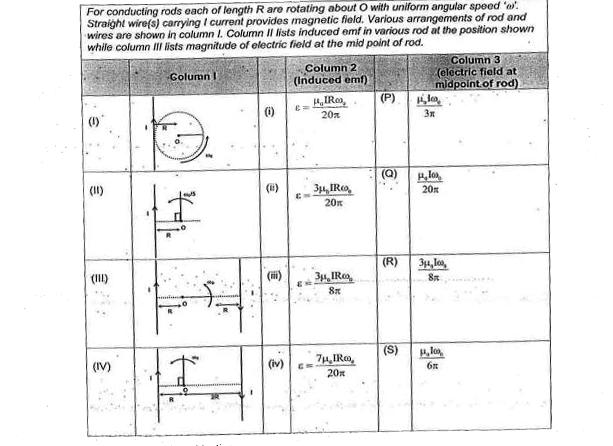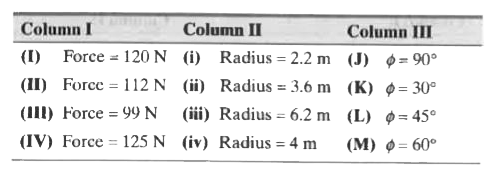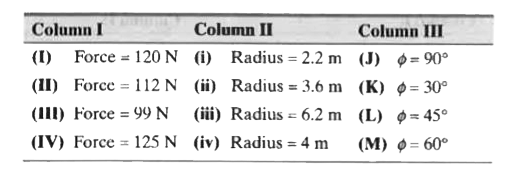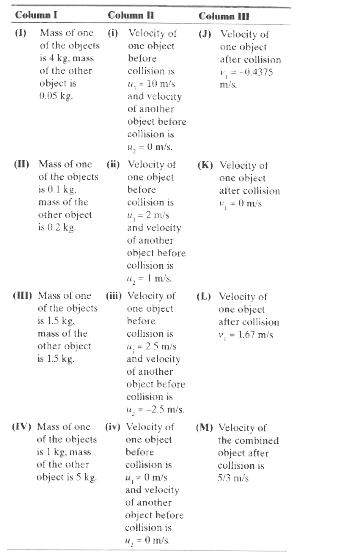In each question, there .is a table having 3 columns and 4 rows. Based on the table, there are 3 questions. Eac!h question bas 4 options (a), (b), (c) and (d), ONLY ONE of these four options is correct.
In the given table, Column I shows different laws in electromagnetic theory, Column II shows the related physica l quantities and Column III shows the equations related to the different laws.
Column IColumn IIColumn II(I) Gauss's law(i)Magnetism (J)∮→B.d→s=μ0ε0dϕEdt+μ0dqdt(II)Ampere's law(ii)Current (K) ∮→B.d→A=0(III)Gauss's law (iii)Induction (L)∮→E.d→s=dϕBdt(IV)Faraday's (iv)Electricity (M)∮→E.d→A=qε
In which law does the charge create diverging electric fields?
(I) (iv) (M)
(IV) (ii) (M)
(II) (i) (M)
(Ill) (iii) (M)
The correct Answer is:A
Topper's Solved these Questions
- ELECTROMAGNETIC WAVES BOOK - RESNICK AND HALLIDAYCHAPTER - ELECTROMAGNETIC WAVES EXERCISE - PRACTICE QUESTIONS (Integer Type)
3 Videos
- ELECTROMAGNETIC WAVES BOOK - RESNICK AND HALLIDAYCHAPTER - ELECTROMAGNETIC WAVES EXERCISE - PRACTICE QUESTIONS (Linked Comprehension)
2 Videos
- ELECTROMAGNETIC OSCILLATIONS AND ALTERNATING CURRENT BOOK - RESNICK AND HALLIDAYCHAPTER - ELECTROMAGNETIC OSCILLATIONS AND ALTERNATING CURRENT EXERCISE - Practice Questions (Integer)
7 Videos
- FLUIDSBOOK - RESNICK AND HALLIDAYCHAPTER - FLUIDSEXERCISE - PRACTICE QUESTIONS (Integer Type )
5 Videos
Similar Questions
The following tables has 3 columns and 4 rows. Based on each table, there are THREE questions. Each question has FOUR options (A), (B), (C), and (D). ONLY ONE of these four options is correct
Q

View SolutionThe following tables has 3 columns and 4 rows. Based on each table, there are THREE questions. Each question has FOUR options (A), (B), (C), and (D). ONLY ONE of these four options is correct
Q

View Solution
Knowledge Check
In each question, there .is a table having 3 columns and 4 rows. Based on the table, there are 3 questions. Eac!h question bas 4 options (a), (b), (c) and (d), ONLY ONE of these four options is correct.
In the given table, Column I shows different laws in electromagnetic theory, Column II shows the related physica l quantities and Column III shows the equations related to the different laws.
Column IColumn IIColumn II(I) Gauss's law (i) Magnetism (J)∮→B.d→s=μ0ε0dϕEdt+μ0dqdt(II)Ampere's law(ii)Current (K) ∮→B.d→A=0(III)Gauss's law (iii)Induction (L)∮→E.d→s=dϕBdt(IV)Faraday's (iv)Electricity(M)∮→E.d→A=qε
Jn which law there are no magnetic monopoles invo lved?A(1) (ii) (J)B(III) (i) (K)C(II) (iii) (L)D(I) (i) (M)In each question, there .is a table having 3 columns and 4 rows. Based on the table, there are 3 questions. Eac!h question bas 4 options (a), (b), (c) and (d), ONLY ONE of these four options is correct.
In the given table, Column I shows different laws in electromagnetic theory, Column II shows the related physica l quantities and Column III shows the equations related to the different laws.
Column IColumn IIColumn II(I) Gauss's law (i) Magnetism (J)∮→B.d→s=μ0ε0dϕEdt+μ0dqdt(II)Ampere's law(ii)Current (K) ∮→B.d→A=0(III)Gauss's law (iii)Induction (L)∮→E.d→s=dϕBdt(IV)Faraday's (iv)Electricity(M)∮→E.d→A=qε
In which law currents or changing electric fi elds(E's) make circulating magnetic fields (B's)?A(II) (ii) (J)B(I) (i) (L)C(IV) (i) (L)D(II) (iii) (M)In each question, there is a table having 3 columns and 4 rows. Based on the table, there are 3 questions. Each question has 4 options (a), (b), ( c) and (d), ONLY ONE of these four options is correct.

Which object has 480N⋅m as the resulting torque (as a vector)?A(I) (iv) (J)B(I) (i) (K)C(III) (iii) (L)D(I) (ii) (L)
The following table has 3 columns and 4 rows. Based on table there are THREE questions. Each question has FOUR options (A) , (B) , ( C) and (D) . ONLY ONE of these four options is correct

View SolutionIn each question, there is a table having 3 columns and 4 rows. Based on the table, there are 3 questions. Each question has 4 options (a), (b), ( c) and (d), ONLY ONE of these four options is correct.

Which object has 137.5N⋅m as the resulting torque (as a vector)?
View SolutionIn each question, there is a table having 3 columns and 4 rows. Based on the table, there are 3 questions. Each question has 4 options (a), (b), ( c) and (d), ONLY ONE of these four options is correct.

Which object has 178.2√3N⋅m as the resulting torque (as a vector)?
View SolutionIn each question, there is a table having 3 columns and 4 rows. Based on the table, there are 3 questions. Each question has 4 options (a), (b), ( c ) and (d), ONLY ONE of these four options in correct.

In which condition is the total momentum after collision 10 kg m/s ?
View SolutionIn each question, there is a table having 3 columns and 4 rows. Based on the table, there are 3 questions. Each question has 4 options (a), (b), (c) and (d), ONLY ONE of these four options is correct.
In the given table Column I lists the elements in the circuit, Column II shows their combination and Column III shows the circuit diagram.

What are the conditions for L=L1+L2?
View Solution
